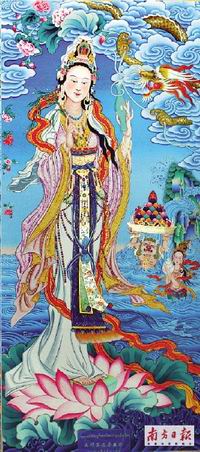"The exhibition will showcase the varied and profound traditional Chinese culture and raise awareness of cultural heritage protection," said Vice Minister of Culture Zhou Heping.
The government was considering new ways to protect intangible cultural heritage while realizing their market potential, he said.
The exhibition features a two-day forum on "productive protection" to discuss appropriate modes of commercialization.
"Traditional arts and crafts should not be preserved for the sake of preservation. Handicrafts should be incorporated into the economic system. They can develop side by side with industrial production," says Lu Pintian, a researcher from the National Academy of Arts.
Lu says productive protection is an effective way to strengthen protection of intangible cultural heritage and benefit local economies.
"Craftsmen use local resources to make handicrafts and hire local residents, which is eco-friendly and conducive to creating jobs," he says.
However, he admits the country had yet to achieve a balance between profit and protection.
 |
|
Tibetan thangka scroll painting
|
Among many endangered intangible cultural heritage items, experts agree that the Tibetan thangka scroll painting is a positive example.
Craftsman Nyangbon, 39, earns more than 200,000 yuan (29,400 U.S. dollars) a year painting and selling thangkas in Tongren County, Huangnan Tibetan Autonomous Prefecture in western Qinghai Province.
"It usually takes one and a half years to make a large thangka piece, but once it's done, it can be sold for up to 350,000 yuan," he says.
Nyangbon and three other thangka masters spent about four million yuan setting up a thangka painting center last year to pass on the craft.
More than 80 apprentices from around the country are studying there.
"I spent about 120,000 yuan myself supporting their study. They don't have to pay at all," Nyangbon says.
The local government is promoting the artworks, raising awareness of the value of thangka and encouraging collectors, he says.
Wang Huaping, deputy head of Huangnan Tibetan Autonomous Prefecture, says the government's efforts and the rich cultural meanings embodied in the thangka arts are the two main reasons for its popularity.
The government has set up a training center from which about 1,000 thangka painters could graduate in 2010, bringing the total number of painters to more than 3,000.
"Thangka has a bright future. Our artists becoming rich, but, most importantly, the skills of Thangka painting are protected," says Wang. "Thangka's example might indicate a way out for other intangible cultural heritage items."
However, Professor Qi Qingfu, at the Central University of Nationalities, fears some local officials and merchants might exploit the intangible cultural heritage for commercial profits.
He cites the example of the "sama festival" of the Dong nationality, in south China's Guizhou Province, which should only be held in the first or second month of the lunar year to worship the goddess grandmother of the Dong. However, it is now repeated through the summer for tourists.
"It is no less than a profanity to force a religious ritual to be held on ordinary days for commercial purposes," he says.
Professor Wu Bing'an, of Liaoning University and deputy director of a state-level expert commission of intangible cultural heritage protection, agrees."To adopt a productive protection policy, we should be very careful about what can be commercialized and what can't."
Unlike paintings or crafts, some intangible cultural heritage items, like traditional customs and religious rituals, are not suitable for productive protection, he says. "This cultural heritage cannot be practiced or duplicated casually for commercial use."
In addition, the government should carefully supervise every aspect of productive protection to prevent abuse or damage to the heritage, he says.
"The government should issue a regulation to clearly define productive protection and how to implement it."
(Xinhua News Agency February 15, 2009)